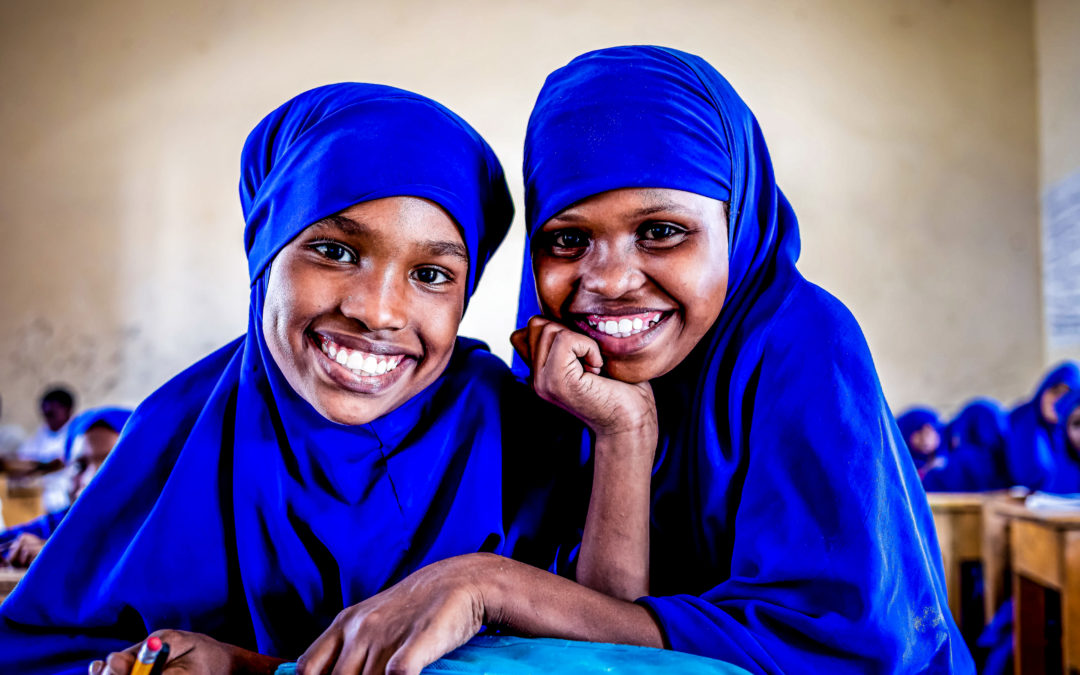Halimo Abdirahman Ismail, 12 years old, and her friend attend class in Mogadishu, Somalia on 23 January 2021.
Credit: Ismail Taxta/UNICEF/2021.
This blog was originally published on Generation Unlimited.
Education will largely determine whether the radical change of the 2020s will reduce or increase the current inequality of opportunity and wealth that characterizes the world today.
One hundred years ago the world was emerging from the last global pandemic, the Spanish flu. Politicians assumed that people would want to go “back to normal”, but they were wrong. Change accelerated as if citizens wanted to make up for the years lost to World War 1 and the pandemic. The Roaring Twenties were a decade of economic growth, of seemingly unbounded energy and new thinking. But just as some benefitted from more prosperous lives, many fell further behind.
We should prepare for the same happening this time. The 2020s will be a decade of astonishing change, driven by technology and the radical economic shifts needed to address the climate. This raises the question: will this change reduce or increase the current inequality of opportunity and wealth? The question is complex, but the answer simple. It’s all about education. It depends on whether we can equip young people, especially those furthest left behind, with the skills and adaptability they will need to thrive. This is also the conclusion of a new report of the World Economic Forum released today.
Unfortunately, for millions, the prospect of acquiring these skills remains elusive. Young people are reaching adulthood woefully ill-equipped. Before the pandemic, millions were already out of school and only 21% of secondary school-age children in low-income and 50% in middle-income countries were on track to reach basic secondary learning benchmarks. The pandemic is likely to worsen these scenarios.
Resetting education for young people
The world needs three disruptions to help reset education for young people and make the 2020s and beyond roaring for everybody.
First, we need a radical change in pedagogy that enables young people to experience far more adaptive and engaging ways of learning. This will be especially relevant as we address learning losses due to school closures, but it will also be critical in the longer term. Adaptive learning practices and targeting teaching by learning level are smart buys for policymakers particularly in countries with wide variations in learning levels. So how do we make this happen at scale? Technology could be a big game-changer in this pedagogical revolution, but its rollout should be rigorously focused on closing equity gaps, not exacerbating them. Close to one-quarter of lower secondary and 18% of upper secondary students are not being reached by any form of digital or broadcast remote learning opportunities. The Education Commission recently launched the High Touch High Tech Global Consortium to explore how we can get the most out of technological opportunities while keeping teachers at the heart of learning. Personalized (high touch) approaches to teaching fostering higher-order and soft skills are combined with adaptive learning (high tech) technologies harnessing the power of artificial intelligence (AI) to tailor instruction to each student’s needs. A prototype in Vietnam illustrates High Touch High Tech’s promise with statistically significant learning gains in particular for students furthest behind.
Second, we need to transform the education workforce. Teachers cannot continue to work alone. New team-based, multisectoral models placing the student at the center have proven effective in health and early childhood education, but their application in general education has been limited. However, COVID-19 school closures mobilized teachers, supported by school leaders, to work closely with parents, caregivers, and community members. These networks of support could become permanent. Working in “learning teams” can enable more effective teaching, targeted remedial learning support and support for inclusion, access to more specialist expertise, and greater on-the-job learning and collaboration between adults. Learning team partnerships across sectors and with the wider community – youth organizations, cultural institutions, and the private sector, for example — can support broader education goals, such as 21st-century skills development and the transition to further education and work.
The first two disruptions will necessitate a third disruption: a rethinking of the way we cost and finance education. Our costing models are based on traditional education delivery models. Using those models, UNESCO estimated that the cost of achieving SDG 4 could increase by over USD $200 billion annually as a result of the pandemic. Disruptions in delivery will affect these estimates and costing models will need to be updated. Financing options will also need to be re-examined. With greater fiscal pressures, governments may be under pressure to cut back on more ambitious education initiatives such as free universal secondary education. Increasing domestic revenue is the most sustainable strategy to fully finance secondary education, but likely to come in the longer term. In the short term, greater rationality in planning and public spending decisions, using principles of progressive universalism, will help identify gaps and clarify where efforts to mobilize alternative financing need to be concentrated. Aid to education is not going to fill the gap and innovative mechanisms, like the International Finance Facility for Education, will be needed. Options to leverage the private sources of finance should also be further explored.
The pandemic has underlined that learning cannot be confined to the classroom alone and secondary education delivery will likely be forever changed. But more testing of the effectiveness and efficiency of alternative models, and their pathways to scale, including their costing and financing, is urgently needed.
This is also one of the important goals of Generation Unlimited’s work, also aligned to UNICEF’s Reimagine Education: to support every young person’s access to learning, skilling, and livelihood opportunities by radically scaling up access to world-class digital solutions that meet this generation’s unique learning needs. We have the tools to craft a modern education so millions of young people can learn online, anytime, anywhere. We must seize this pivotal moment to ensure all young people can access opportunities to develop the skills they need to thrive and flourish. A Roaring Twenties for the COVID-19 generation may seem ambitious, but it is not impossible. The Save Our Future global coalition of more than 200 organizations demonstrates there is an appetite across the international community to revitalize education and ensure the COVID recovery creates a more just and sustainable future – with the education of our children and youth at the center.

